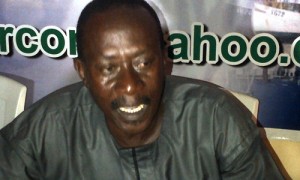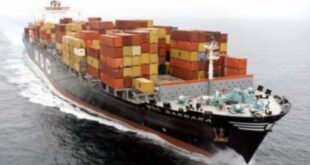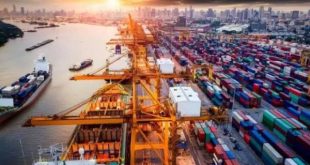
In this week’s edition of your educative Shippers’ Guide with Captain Thomas Kemenerigha, former president of the Nigerian Merchant Navy Officers and Water Transport Senior Staff Association and captain, you will enjoy it as he gives you a firsthand experience and know-how of navigation at sea; he narrates the intricacies of the working on board a ship which includes the safety parameters. He also explains what a nautical mile means in ship voyage.
What do you need to do to become a ship captain?
Ideally, you secure admission into the Maritime Academy, Oron with your O’ Level result, you spend two years and after the two years study, you will go for sea time training. The sea time goes in two ways; it could be limited or unlimited. If you go for twelve months sea time, it qualifies you for the limited Certificate of Competency (COC). If you go above 18 months, it qualifies you for unlimited COC that is when you can be certified to start your sea career as officer of the watch. When you become an officer of the watch, there is specific number of months or years you spend in-between to go for the next stage of your COC, if you do that, you get your masters.
How do you navigate at sea looking at the length and breadth of a ship?

Now the issue of navigating at sea, the lay man is always surprised how we know where we are going. Before this time that technology has taken over a lot of things and has made the job easier, what we had was what we called chart. A chart is the road map movement at sea because as wide as the sea is, you just don’t move anyhow, the chart indicates a channel just as we have Lagos anchorage; when you get to the fare way buoy, you pass the fareway buoy in a distance and move about 5 to 10 miles in a particular course from the shore. They are in two ways; this is the shore and this is the fare way buoy and you are in the middle, you know the distance to each and then fix your position on the chart.
If you are going to Cote D’Ivore, you take your bearing on the course you will take to get to Cote D’Ivore, you plant it into your compass and the compass tells you to hold course of 150 South West or South East. So, sailing from one point to another is determined by the chosen course. Today, it is easier as GPS and other devices. At any point in time, you can place the position where you are and the country you are going falls into longitude and latitude and once you enter into the country, the longitude and latitude will show. There is what is called radar like a television on board, it gives you the clear picture of the coast you are but when you are far deep and you don’t see the shore, it will give you the position in longitude and latitude then you go to the chart and plot your longitude and latitude position and in that position, you know where you are. Then, if you are going by the coast there is the area where ship is indicated in the chart so if you course line falls within where the ship is, before you get there, you alter your course.
All movement at high sea depends on the navigation of the chart of that very area you are, youjust don’t move anyhow, you work out your movement relating to the chart plot in your compass, your GPS will give you your position and where you are going.
What do you need to do in case of storm or an emergency?
It depends on the operational content of the vessel. You have coastal;you also have the fishing vessel which goes for fishing. At any point in time, the captain determines the state of the vessel; there could be a very strong weather that is not conducive for that vessel to carry out its fishing, the captain has to use his discretion as the master on board may be to stop the fishing or steer the vessel for safety. It could be a coastal charter, the captain must take into consideration the position he finds himself because the safety of the vessel is more important. For example, in our Lagos anchorage here, there was a strong surge and the wind that came and the captain had to take a decision to take up the anchor or you keep the vessel at the level of safety. It is also the captain that determines the safety precautions. This is why everybody on a vessel must pass through the Safety requirements laid down by the association. If there is fire on board, everybody knows where they should gather, you must leave everything you are doing to make sure you get to that meeting point and a roll call will be made of each person to make sure all the staff that came to work that day are present and if anyone is missing, then they have to find a means to get the fire fighters, all these processes the crew have to pass through. You don’t just come and say you want to work 9on board a vessel, the regulatory certificate is mandatory for everyone on board. So, if you passed through the programme, at any point, you will know what to do on board.
What do you do when visibility on board is not good enough?
We have radar and other equipments. Assuming there is a heavy downpour, you put on your radar and with the radar, you will see far objects and it will give you all the pictures around you which will be seen in dots form. If there is a vessel coming, the other man also has radar, you can see him and he can see you. Ordinarily, when you are on board, you don’t see front but there is equipment that directs you, gives you a clear view, as you are moving, he is moving and the distance will become closer and there will be a safe passage. But if you cannot see the vessel very clearly, the equipments will indicate objects even though it is a jacket, a non-moving object, you will see it and you know the object is static when the object is at a distance and you approach it at 10 miles, you move two miles or you further and the object is still stationary.
What is a nautical mile?
A nautical mile is mileage coverage at sea as it applies to land but it is not the same calculation for land and sea.
In case you are at sea navigating and something suddenly crosses your path and you need to stop abruptly to avoid harm, is it possible?
Yes it is but it depends on the state of mind of the captain because I know if you are moving and you want to stop the vessel, it will still move a distance before it will finally stop.
What distance will it move before stopping?
It depends on the closeness. For example, a vessel is moving at a reasonable speed and your radar is yet to pick a new object in front of you, may be you were sleeping and you woke up suddenly, even you slow down and become neutral, the vessel will still move a distance, you know you are on top of water, the current is a factor and the tide will determine where the vessel will be going and it also depends on the state of mind of the captain. So, you alter your course the best way you can avoid it because speed at which the collisions meets also determines the damage. Just like a vehicle on high speed, the rate of damage depends on the speed. This is why we have men on watch who watch out the duty roster for the person on duty.
How many nautical miles can a ship cover in one hour?
It depends on the engine and the state of the vessel. You know how many nauts you are making; we call it nauts. I am going at 10 nautical miles per hour; some go 20 while some go 30 nautical miles per hour. It all depends on the state of the current against the vessel because the current too has speed. If the current coming from this way and the current is very high, you will not get your exact speed of the vessel because you are going against the current, you get more speed when you are going in favour of the current and it depends on the nautical miles the vessel is making and it also depends on the engine of the vessel, the load the vessel is carrying. So, the speed of a vessel per say is not fixed. For example, if I am going to Ghana and I am in favour of the current with the nautical miles I am making, I might make it in 18 hours to Ghana. This does not mean that the vessel coming to Nigeria from Ghana will make it in the same 18 hours.
Who calls the shot between the Chief Engineer and the captain in a ship?
The captain is the sole representative of the management on board a ship. He is in charge of the vessel, the Chief Engineer heads a department while the captain controls the whole vessel, the captain has four stripes, the Chief Engineer has four stripes but the Chief Engineer controls a department while the captain controls everybody on board the vessel.
It is the Chief Officer that is next to the captain that has the same function as the Chief Engineer because the Chief Officer controls the deck; the Chief Engineer the engine room, the captain oversees the affairs of everybody. In summary, the captain’s instruction is a law.
 MMS PLUS NG – Maritime, Aviation, Business, Oil and Gas News Online Newspaper with coverage in Maritime, Oil and Gas, Aviation, Power and Energy as well as Financial News
MMS PLUS NG – Maritime, Aviation, Business, Oil and Gas News Online Newspaper with coverage in Maritime, Oil and Gas, Aviation, Power and Energy as well as Financial News









